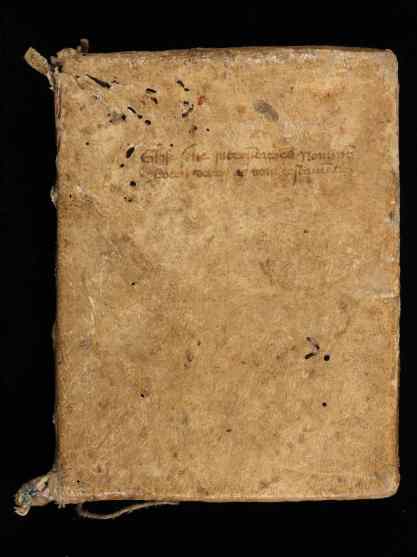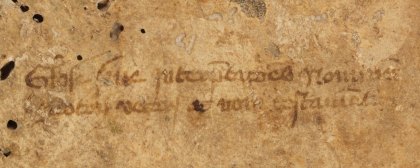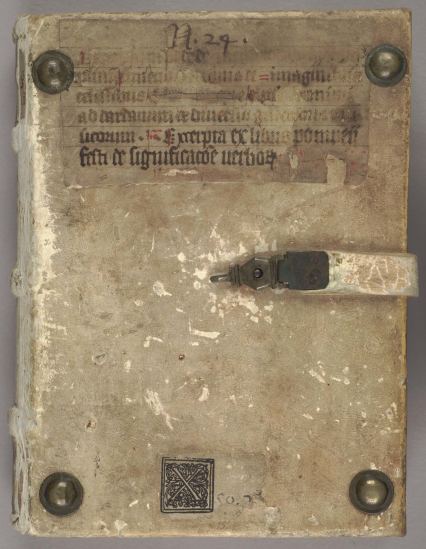What a clever device the book is. It is compact and light, yet contains hundreds of pages that hold an incredible amount of information. Moving forward or backward in the text is as easy as flipping a page, while the book’s square shape and flat bottom facilitates easy shelving. Still, the object is useless if the information it contains cannot be found. And so tools were developed to help the reader do just that, such as page numbers, running titles, and indices. As familiar as these aids may be, they are older than you think. The page number, for example, is encountered in papyrus manuscripts made some two thousand years ago (see this older blog post).
Crucially, to look up information in a book you must have first located the object. And so the shelfmark was invented, the equivalent of our call number. By the end of the medieval period it had become as clever as the book to which it was added: letters, digits, and even colour coding was used to guide the reader to a particular manuscript (see this post on GPS in the medieval library). This post explores the medieval roots of yet another tool for finding a specific book, one that is as popular now as it was in medieval times: title and author information displayed on the spine and dust jacket. How did the outside of the medieval manuscript communicate what was hidden inside?
1. Text on leather


Why make things complicated? The easiest way to identify a manuscript was to simply jot the title on the front cover, straight on the leather of the binding (Figs. 1-2). Although one might imagine that this is how the tradition of our modern cover information began, there are too few original bindings left to know for sure. The manuscript seen in Figs. 1-2 is important as it shows that the practice goes back to at least the fourteenth century.
The manuscript shown in Figs. 1-2 was copied around 1100 and still has its original binding. Interestingly, this tells us that for 200-300 years users were quite content with an “anonymous” book, which did not provide a clue to what information it contained. This is all the more striking when you consider that during these three centuries the library where the object was held, in the abbey of St Gall, harboured several hundred books. How on earth did the monks find their way to the texts contained within this binding?
2. Title labels


Writing text on a manuscript’s cover, as seen in Fig. 2, was not easy. The structure of the leather could be coarse and the surface uneven, which made it potentially difficult to write the title information legibly. More importantly, when the leather had a dark color, a black title may simply not be visible. In such cases it made more sense to write the information on a parchment or paper slip – a label – that was subsequently pasted on the cover, as is still common practice in libraries today.
The manuscript in Figs. 3-4, which features a parchment label, shows how incredibly effective this practice was: it clearly reads Liber ethymolo[giarum] Isidori, telling the reader that he was about to open Isidore of Seville’s Etymologies. These paste-on labels could be quite extensive (Fig. 5). In fact, some book owners preferred to have the entire contents displayed on the outside, even if the object held ten works (Fig. 6).


As detailed as these labels are, they exclusively list the titles of the works contained by the manuscript, not the authors’ names. It appears as if the librarian who labeled these manuscripts judged the title (and not the author) to be the best identifier of the object.
3. The fenestra
Paper or parchment title shields were sometimes placed under a thin piece of horn (bone), for protection (Figs. 7-8). The so-called “fenestra” (window in Latin) was secured to the wooden cover with nails: it was clearly going nowhere (Fig. 8). This type of cover information can be seen as the next step in the process of providing efficient book titles: a clear and permanent label, hammered into wooden boards with nails. It is a far cry from the on-the-fly title hastily written directly on leather (here is another example).


The fenestra is often found on manuscripts that were part of a well-organised library. It may therefore contain quite a bit more information than merely the title or the author. The one seen in Fig. 8 is from the library of the Carthusian house of Syon in Middlesex, England. The label is clever and reads: “V. Beda de gestis Anglorum. Idem super actus apostolorum et epistolas canonicas. 2o fo et prassini”. The main piece of information concerns what is found inside: Bede’s Ecclesiastical History of the English People and Bede’s commentaries on the Acts of the Apostles and on the New Testament’s Canonical Epistles.
However, it also mentions the first words of the second folium: secundum folium [incipit] et prassini, the second folium starts with “et prassini”. These words formed a unique identifier, for no two copies of Bede’s Ecclesiastical History will have had these very words at the start of the second leaf. This technique was commonly used to identify unique copies for inclusion in a monastery’s book inventory or library catalogue. It is probable that this is the reason why the fenestra contains the phrase: to link this specific book to the monastery’s catalogue.
4. Spine titles

Not only was a book’s title and name of the author jotted down on the front cover, it would ultimately also feature on the spine, as any modern reader knows. This part of the tradition has its own path of development. It all started on the fore-edge, the long side of the book that shows the paper or parchment pages. From at least the fourteenth century decoration was added to this location. Few books have been so lavishly decorated as Ordorico Pillone’s, who, around 1580, had the artist Cesare Vecellio decorate the fore-edge of 172 books in his library with stunning designs (Fig. 9). The technique would be perfected in the nineteenth century, when the magically disappearing fore-edge decoration was invented (example here).
In medieval times the edges of the book block were not usually decorated, while the design was commonly modest (Fig. 10-11). Although there are exceptions to this rule, as a potentially medieval fore-edge decoration in Durham shows (more here).


The manuscript in Fig. 11 shows that medieval fore-edge decoration could serve a functional purpose, because it concerns the coat of arms of Jean, duc de Berry (d. 1416). We may assume the books in his library were positioned with the fore-edge faced outward, as was common practice in many medieval libraries – in fact, this was done until well into the 17th century, as this image shows. How impressive his library must have looked to visitors: dozens of precious books, all evidently owned by the duke.
Given that the fore-edge was facing the reader, this location was also the perfect place to write down the title or author of the work contained by the volume. ‘Quaestiones morales’ (moral questions), a 15th-century hand wrote on the fore edge of an incunable printed in 1489 (Fig. 12). The earliest cases I encountered date from the early fifteenth century, although our view may be skewed because such fore-edge titles disappeared when binders in the early-modern period refitted the books with new bindings.

When books finally turned their backs to the reader, the title ended up where it is still found today: on the spine. Based on my own experience, this practice was not common in medieval times, for the simple fact that manuscripts were not usually placed with their backs facing the reader. Cases from the early-modern period are plentiful. In fact, it became so popular that some readers wrote extensive tables of contents on the backs of their books (Fig. 13).

The early history of displaying a book’s title and author on the outside is long and winding: first the information was found on the front or back, then on the fore-edge, and finally on the spine. This order is no coincidence, because it roughly reflects another development, namely how books were stored: first flat (Early and Central Middle Ages), then upright with the fore-edge facing the reader (Later Middle Ages), and finally with the spine facing outward (Early Modern period).
Judging from surviving book bindings, the history of the “dust jacket” with title actually starts surprisingly late. After all, the earliest traceable specimens date from the fourteenth century. Curiously, in the same century the Latin titulus was first used for denoting the title of a book (see here), which may also indicate that titles did not exist before then. If correct, this reconstruction suggests that for much of the Middle Ages readers could not tell what texts were found inside a book. Generations of frustrated monks had to wander through the library opening and closing manuscripts until they had found what they were looking for.


Super cool!
LikeLike
Thank you!
LikeLiked by 1 person
An interesting twist to a common blog title. I appreciated the information, it sounds like I will definitely like coming over for more book history after reading just two posts. Ben recommended your blog via the Daily Post.
LikeLike
Excellent!
LikeLike
They do smell – and I always let my students experience that first-hand.
LikeLike
It must be so exciting to be able to touch and hold such books. What a priviledge! I love the books pictured at the header. Can I ask whether they smell good? A serious-if a little weird perhaps- question. I always divide book-readers into two groups -those that just ‘read’ and those experience them sensorily-touch, smell and the sound of the pages and savour them as beautiful objects beyond their worth as vessels of entertainment or information.
LikeLike
Excellent point. I took a bit of literary liberty at the end of the post: you are the second person to call me on it. Monks will have known their libraries well. Still, it must have been hard, at times, to find a particular book. After all, if my hypothesis is correct that labels were a rather late invention, it follows that books looked roughly the same: square objects with dark leather on the outside!
LikeLike
Really interesting post, thanks! It’s always amazing to me to stop and think about the origins of so many aspects of books that we take for granted. They’re pretty amazing devices.
But, a question, from someone not knowledgeable in this field.
“Generations of frustrated monks had to wander through the library opening and closing manuscripts until they had found what they were looking for.”
Wouldn’t the monks have known their collections well? When I’m trying to put my hands on a book that I own, I usually have in my mind a sense of its size, shape, colour, texture, etc.—I’m not relying on the spine label very much, except maybe to differentiate several volumes in a series, or help jog my memory about a book acquired long ago and not much appreciated. Were the numbers of books in a typical library so large, and their outward appearances so *very* similar (even dark-leatherbound volumes seem to me to have a lot of individual character)?
Or did the monks have a lot of other duties that meant they spent less time with their book collections than I imagine?
LikeLike
I thoroughly enjoyed this post. Thanks! I learned a few things about the history of books (love the fore-edge art!) Looking forward to browsing through the site.
LikeLike
Each book’s location was set, so they wouldn’t have need to go through all the books. Larger libraries had lists of where each book was located, which would (much) later also be organized by author and subject for indexing purposes.
LikeLike
Thanks for this!
LikeLike
Today, we can’t believe the spine-with its convenient and more smooth surface-wasn’t always used to communicate the title.
It makes me wonder what we do today that won’t make sense 500 years from now.
LikeLike
Thanks for a splendid post. Another example of books being shown ‘spine out’ in the early C17 is the Monument to Dean John Boys, Chapel of Our Lady Martyrdom, Canterbury Cathedral. He had died suddenly among his books in September of 1625.
This is a link to photographs taken by Bill Brandt in December 1941, as a record in the event of the monuments wartime destruction,
http://archive.historicengland.org.uk/results/resultsaj.aspx?t=Quick&cr=Canterbury+Dean+Boys&io=False&l=all
LikeLike
Thanks for this post! I think that Greek and Roman scrolls often had a short tag attached at the top by a cord or ribbon with a label, so people could read the title without taking the scroll out of its case or pidgeonhole and unrolling it. Keeping track of the contents of miscellanea in medieval libraries must have challenged librarians’ memories …
LikeLike
Thanks for this post! I think that Greek and Roman scrolls often had a short tag attached at the top by a cord or ribbon with a label, so people could read the title without taking the scroll out of its case or pidgeonholl and unrolling it. Keeping track of the contents of miscellanea in medieval libraries must have challenged librarians’ memories … I have also heard that as late as the 17th century binders would sometimes strip the covers off several short manuscripts and rebind them together into something with a convenient number of pages and a cover which matched the other covers in their new home.
LikeLike
I have encountered one further (early modern) practice in the library of Albertus Hardenberg (c. 1510-1574, now in the Bibliothek der Grossen Kirche in Emden).
In some of his books a largish label (around 2-3 cm2) was glued to one of the first pages in the book. When the book was closed the label would stick out of the top of the book.
LikeLike
I have encountered one further (early modern) practice (in the library of Albertus Hardenberg, c. 1510-1574, now in the Bibliothek der Grossen Kirche in Emden). In some of his books a largish label (2-3 cm2) was glued to one of the first pages in the book. When the book was closed the label would stick out of the book (at the top).
LikeLike
Thank you for such illuminating information- especially in the age where printed matter is more associated with being a memory of what was instead of what is to come.
LikeLike
Thank you. A pleasure to read.
LikeLike
I find the remark of Otto Vervaart very interesting. Maybe the appearance of labelings on the outside of books at the beginning of the early modern periode indicates a change in the way libraries where used, from a library where a librarian who knew his books controlled who would get to read what, to a library where people did their own research and could decide themselves what they would read. Information was perhaps beginning to be slipping away from the control of the (church) authorities.
LikeLike
Great sharings .
LikeLike
Reblogged this on Analogue Humanist.
LikeLike
Some: the credits say EK. I enjoy making them but it is often easier to use Creative Commons images.
LikeLike
Well, that’s nice to hear! Sharing is nice, though it does take time to create these posts. So your kind remark is appreciated!
LikeLike
I just LOVE your blog. Do you take your own photos?
LikeLike
Reblogged this on Thanks For Pointing That Out… and commented:
AS an Illuminating folk artist I enjoy this blog.
LikeLike
Dear Erik: Thank you so much for this delightful article. I love reading these and truly appreciate the time and effort you put into these wonderful works!
LikeLike
Very informative, thank you, and beautiful to look at.
LikeLike
Yes, you are right, of course: the very last line was expressed so boldly because I was looking for a fun way to end this – fairly heavy – post. There will have been a collective memory as to what the library contained; I imagine that the librarian knew where to find a text, although he probably had to go from visual memory, namely by what he remembered the binding to look like.
LikeLiked by 1 person
Reblogged this on Dead Machinery's Blog and commented:
Wonderful information about how books as we know them today came to be…and lots of inspiration for artists books’ makers 🙂
LikeLike
Dear Erik, first of all thanks for your new post, it was well worth waiting for! Your last remark does lead me to some remarks. Did medieval monks really wander through the library of their monastery? The Rule of St. Benedict says at some point (48,16) that monks will receive a book at the start of Lent. I suppose the librarian – and perhaps his assistant(s) – handed over these books. These librarians often knew the holdings of a monastery by heart. You might look at monastic constitutions for more details about such practices. Anyway, even in the twentieth century some scholars who founded libraries acted as its living catalogue and guide.
LikeLiked by 1 person